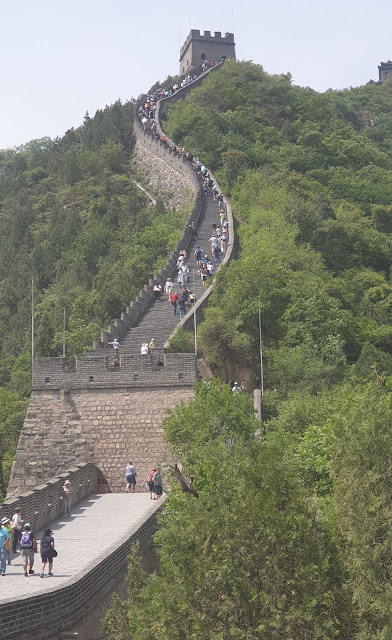This is the bus we had in Beijing
Beijing train station.
This place is huge and there are so many people here, perhaps the other half of Beijing's population that wasn't at the forbidden city.
Getting into the station looked like it was going to be fraught with danger but the tour guide got us into the right queue and then arranged for a separate scanner for the group to help keep us all together
Then we decided to take the VIP service and got to waiting room no 13, the VIP service waiting room which was full to overflowing. Everyone today was a VIP. We got the red hat guy to lead us to a special area away from the crowd.
Actually, it was on the other side of the gate, away from the hoards sitting or standing patiently in the waiting room. It gave us a chance to get something to eat before the long train ride.
Departure is at 4 pm, and the trains leave on time. As it is a high-speed train, stops are far and few between, but we're lucky, this time, in that we don't have to count stations to know where to get off.
We're going to the end of the line.
A train ride with a difference
To make the 5 and a half hours go quicker we keep an eye on the speed which hovers between 290 and 305 kph, and sitting their with our camera waiting for the speed to hit 305 which is a rare occurrence, and then, for 306 and then for 307, which happened when we all took a stroll up to the restaurant car to find there had nothing to eat.
I got a strange flavoured drink for 20 yuan.
There was a lady manning a trolley that had some food, and fresh, maybe, fruit on it, and she had a sense of humour if not much English.
We didn't but anything but the barrel of caramel popcorn looked good.
The good thing was, after hovering around 298, and 299 kph, it finally hit 300.
We get to the end of the line, and there is an announcement in Chinese which we don't understand and attempts to find out if it is the last station fall on deaf ears, probably more to do with the language barrier than anything else.
Then, suddenly the train conductor, the lady with the red hat, comes and tell us it is, and we have fifteen minutes, so we're now hurrying to get off.
As the group were are scattered up and down the platform, we all come together and we go down the escalator, and, at the bottom, we see the trip a deal flags.
X’ian
This time we have a male guide, Sam, and have a few hiccups before we head to the bus. Some of our travellers are not on his list, but with the other group. Apparently a trip a deal mix up or miscommunication perhaps.
Then it's another long walk with bags to the bus. Good thing its a nicely air-conditioned newish bus, and there's water, and beer for 10 yuan. How could you pass up a tsing tao for that price?
Xi’an is a very brightly lit up city at night with wide roads. It is very welcoming, and a surprise for a city of 10 million out in the middle of China.
As with all hotels, it's about a 50-minute drive from the railway station and we are all tired by the time we get there.
Tomorrow’s program will be up at 6, on the bus 8.40 and off to the soldiers, 2.00 late lunch, then train station to catch the 4.00 train, that will arrive at 2 hours later at the next stop. A not so late night this time.
The Grand Noble Hotel
The Grand Noble Hotel, like the Friendship Hotel, had a very flash foyer with tons of polished marble. It sent out warning signals, but when we got to our room, we found it to be absolutely stunning. More room, a large bathroom, air conditioning the works.
Only one small problem, as in Beijing the lighting is inadequate. Other than that it's what I would call a five-star hotel. This one is definitely better than the Friendship Hotel.
In the centre of the city, very close to the bell tower, one of the few ancient buildings left in Xi’an. It is also in the middle of a larger roundabout and had a guard with a machine gun.
Sadly there was no time for city centre sightseeing.


































